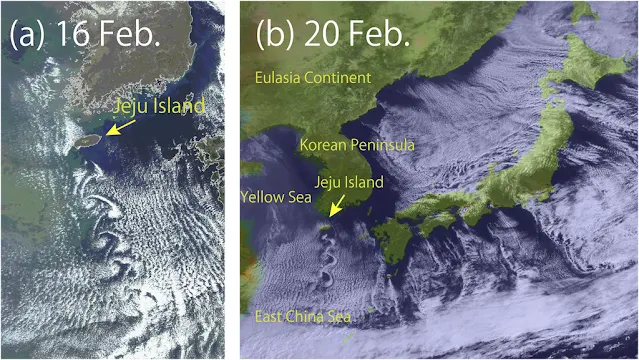Von Kármán vortex cloud swirls from Jeju Island of Republic of Korea (South Korea)
This Copernicus Sentinel-3 image acquired on 19 April 2021 shows several vortical cloud patterns swirling downwind south of the Spanish Canary Islands, off the coast of northwestern Africa.
These beautiful spiral clouds, known as Von Kármán vortices, form when atmospheric circulation is disturbed by the presence of mountainous obstacles. The peculiar spiral clouds which can be seen in this image were formed as the wind airflow was deflected by the relief of the Canary Islands. These Von Kármán vortices can be seen extending 400 km southwest due to the strong trade winds that were blowing at the time the image was acquired.
The study of atmospheric phenomena is fundamental to the understanding the fluid dynamics that underly numerous scenarios of our daily lives, from aircraft take-offs to the change in weather conditions. Open data supplied by the Copernicus Sentinel-3 mission are crucial in the advancement of scientific knowledge on cloud dynamics and climate analysis.
Citation: Monthly Weather Review 144, 1; 10.1175/MWR-D-14-00406.1 |
A mesoscale atmospheric numerical model is used to simulate two cases of Kármán vortex shedding in the lee of Jeju Island, South Korea, in the winter of 2013. Observed cloud patterns associated with the Kármán vortex shedding are successfully reproduced. When the winter monsoon flows out from the Eurasian continent, a convective mixed layer develops through the supply of heat and moisture from the relatively warm Yellow Sea and encounters Jeju Island and dynamical conditions favorable for the formation of lee vortices are realized. Vortices that form behind the island induce updrafts to trigger cloud formation at the top of the convective boundary layer. A sensitivity experiment in which surface drag on the island is eliminated demonstrates that the formation mechanism of the atmospheric Kármán vortex shedding is different from that behind a bluff body in classical fluid mechanics.
<2023.01.01 Satellite Himawari-8 >
<2023.12.20 Satellite Himawari-8 >




Comments
Post a Comment